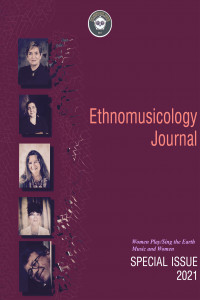Öz
Kaynakça
- Ardevol, E. & G6mez-Cruz, E. (2014). Digital Ethnography and Media Practices. In Darling-Wolf F. (Ed.), The International Encyclopedia of Media Studies, Vol. VII: Research Methods in Media Studies, 22 (pp. 1-21). John Wiley & Sons, Ltd.
- Bindu, K. (2013). Percussion Art Forms: Aspekte der Produktion und Kommunikation südindischer Talas im Kut.iyat.t.am. München, Wien: Lit Verlag.
- Goldenseedmusic (2012). When The Drummers Were Women With Layne Redmond. Retrieved from https://www.youtube.com/watch?v=8o- OnwYrsWE0/
- G6ralska, M. (2020). Anthropology from Home. Advice on Digital Ethnography for the Pandemic Times. In Anthropology in Action, 27, no.1 (pp. 46-52). Berghahn Books
- Kremser, M. (2001). Shang6 - Transformationen. Vom traditionellen Donnergott der Yoruba zum digitalen Blitzgewitter im Cyberspace. Prolegomena zu einer Theorie des Shang6 - Phanomens und der Beziehungen zwischen transzendenter Spiritualitat und kultureller Kreativitat. Habilitationsschrift. Universitat Wien: Fakultat für Human- und Sozialwis- senschaften.
- Leavy, P. (2009). Method meets Art. Art-Based Research Practice. New York: Guilford Press
- Lupton, D. (Ed.) (2021). Doing fieldwork in a pandemic (crowd-sourced document), revised version. Available at: DOING FIELDWORK IN A PANDEMIC
Öz
Layne Redmond, a devoted female master drummer, dedicated her life to research about the history and mythology of frame drums in relation to the female spiritual power until her death in 2013. By collecting images, which show statues, carvings, and paintings of drumming women in museums, books and historical sites in Southern Europe and the Middle East, she reconstructed the history of drumming women. Beside various activities for the welfare of their communities, their roles had been related to the devotion of the great mother goddess as symbol of life, as source of nature, transcendence, knowledge, and procreation. Thousands of years women had acted as priestesses, prophetesses and agents of communication between humans and spiritual forces. Around the 3rd century A.D., the Great Mother, worshipped as Kybele in Phrygia, Greece, and Italy, lost her spiritual power. Christianity and male dominated social systems moved towards oppressing female powers including ritual drumming. Among other functional changes the drums have been misused for male activities in the context of war.
Inspired by the ancient history Layne Redmond created her own circles of drumming women ("the mob of angels"), who reenacted the power of female drumming in the context of new specific public and private rituals. As master drummer and creator of a revitalized female consciousness she remained an idol for many people following her path. Some of her followers founded digital communities to share and promote their experiences. The Facebook groups "Layne Redmond's Global Friends and fans", and "When the Drummers Are Women" are among those.
Within these groups I undertook a first attempt to expo- se categories of contemporary female frame drummer's intentions based on Redmond's book "When the Drummers Are Women" and on my own experiences as a fema- le drummer.
Are female drummers basically focused on music, on healing methods, empowerment of women, on spiritual concepts or on other aspects of drumming? What kind of identity could they create in society? Which role models are they creating and representing for future generations? Considering various dilemmas of digital ethnography described by Magdalena G6ralska (2020) and Deborah Lupton (2020), this will nevertheless be one of the first glimpses into my new research project about drumming women. Methodically I combined Art Based Research, Qualitative Social Research, Digital Ethnography and Ethnomusicology. Digital Ethnography is introduced here in historical and methodological perspective including re- commended instructions for digital fıeld research.
Anahtar Kelimeler
Frame Drums female empowerment Ethnomusicology digital research gender female drummers percussion Art based researche
Kaynakça
- Ardevol, E. & G6mez-Cruz, E. (2014). Digital Ethnography and Media Practices. In Darling-Wolf F. (Ed.), The International Encyclopedia of Media Studies, Vol. VII: Research Methods in Media Studies, 22 (pp. 1-21). John Wiley & Sons, Ltd.
- Bindu, K. (2013). Percussion Art Forms: Aspekte der Produktion und Kommunikation südindischer Talas im Kut.iyat.t.am. München, Wien: Lit Verlag.
- Goldenseedmusic (2012). When The Drummers Were Women With Layne Redmond. Retrieved from https://www.youtube.com/watch?v=8o- OnwYrsWE0/
- G6ralska, M. (2020). Anthropology from Home. Advice on Digital Ethnography for the Pandemic Times. In Anthropology in Action, 27, no.1 (pp. 46-52). Berghahn Books
- Kremser, M. (2001). Shang6 - Transformationen. Vom traditionellen Donnergott der Yoruba zum digitalen Blitzgewitter im Cyberspace. Prolegomena zu einer Theorie des Shang6 - Phanomens und der Beziehungen zwischen transzendenter Spiritualitat und kultureller Kreativitat. Habilitationsschrift. Universitat Wien: Fakultat für Human- und Sozialwis- senschaften.
- Leavy, P. (2009). Method meets Art. Art-Based Research Practice. New York: Guilford Press
- Lupton, D. (Ed.) (2021). Doing fieldwork in a pandemic (crowd-sourced document), revised version. Available at: DOING FIELDWORK IN A PANDEMIC
Ayrıntılar
| Birincil Dil | İngilizce |
|---|---|
| Konular | Kültürel çalışmalar, Müzik |
| Bölüm | Araştırma Makaleleri |
| Yazarlar | |
| Yayımlanma Tarihi | 30 Aralık 2021 |
| Gönderilme Tarihi | 2 Eylül 2021 |
| Yayımlandığı Sayı | Yıl 2021 Cilt: 4 - Ethnomusicology journal Special Issue / Women Play Sing the Earth-Music and Women |


